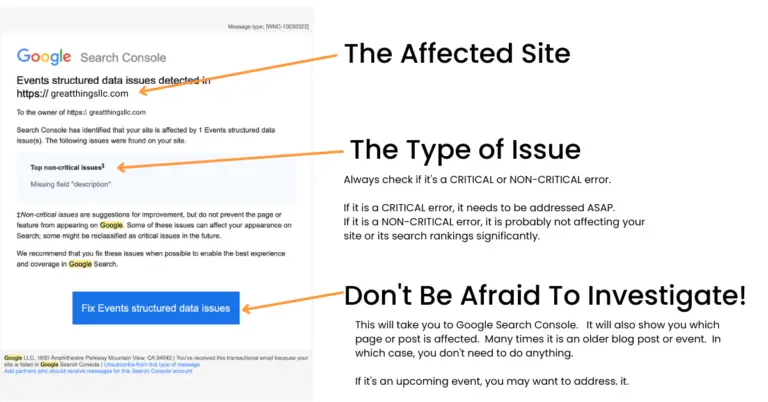Google Events structured data alerts are so lame: A blog about the Google structured data notifications and why they are lame.
Let’s face it: Google Analytics is important. Every website should have either a free one or a premium one. The reason they are so important is that they help you to understand your web traffic and to see what’s working and what isn’t. If something isn’t working, then you can make changes to optimize that part of your website so that more people find it helpful, or at least visit it, instead of them bouncing back to the search results because they didn’t find what they were looking for. I’m sure that pretty much anybody with a WordPress site has gotten at least one of these notifications from Google about rich snippets.
Let’s start with Structured Data. What is it?
Structured Data has its roots back in the 1970’s and IBM. The advent of the database (a group of related and organized data tables) identified the need for standards on how data is categorized and can interoperate with other systems. Google uses these standards to organize and provide information that allows the search engines to better understand, classify, and rank pages that are relevant to users’ searches. Websites need to be built with this standard in mind. For the most part, WordPress and Elementor take care of that in the background. However, schema changes, WordPress & Plugin Updates, and many other things can cause small pieces of the structured data to be “missing” or incorrect.
So what is a “Rich Snippet”? And why should you care?
Let’s hear it in Google’s own words:
Rich Snippets give users convenient summary information about their search results at a glance. We are currently supporting data about reviews and people. When searching for a product or service, users can easily see reviews and ratings, and when searching for a person, they’ll get help distinguishing between people with the same name. It’s a simple change to the display of search results, yet our experiments have shown that users find the new data valuable—if they see useful and relevant information from the page, they are more likely to click through. Now we’re beginning the process of opening up this successful experiment so that more websites can participate. As a site owner, you can help by annotating your pages with structured data in a standard format.
To display Rich Snippets, Google looks for markup formats (microformats and RDFa) that you can easily add to your own web pages. In most cases, it’s as quick as wrapping the existing data on your web pages with some additional tags.
When you perform a search, a summary of the page or post is presented to you. This is the Rich Snippet. Below you can see the Rich Snippet that comes up for Great Things LLC on Google. You may recognize this format from your own searches.

So where does this information come from?
It comes from the MetaData on each individual page and post. If you are using YOAST SEO or SQUIRRLY SEO, you can easily view and update this information. I have found that Squirrly SEO is the best option for this work, and highly recommend it. My sites have been moved over and have had a noticeable improvement in results.
Now For The LAME and Voluminous Google Alerts You May Be Receiving
Does this email look familiar? Have you gotten a ba’zillion of these? Does it increase your anxiety everytime? These alerts are created each time Google crawls you site and finds (or doesn’t see) something it likes. As standards and plugins change, what may have been good before, can be throwing an error now. There are a multitude of reasons that alerts will be created. The trick is learning to decipher which ones to worry about.
That said, , they are usually just informational. Here is how to interpret and use these alerts.

Conclusion
In my opinion, Google structured data notifications are fairly useless. Here is a list of reasons why:
- They almost always say the same thing. This is even true across industries and software versions, from custom posts to product feeds. No matter what you are doing, it is likely that you have seen these notifications hundreds of times by now.
- They are often so vague they do not provide any constructive information that you can use to improve your content.
- The suggestion options below the notification give few viable options besides vanity metrics like rich snippets and enhanced sitelinks.
- For products, they do not even allow you to generate a sitelink unless you have a display URL set up (most eCommerce websites don’t).
- For custom post types or other non-post content types, if you do have a useful display URL (a rarity among WordPress users), they will often corrupt it by making it hyperlink-only instead of leaving it as pure text (even though hyperlinks still show up normally in the source code).
- For posts containing the structure data for multiple entities in one post, such as posts with many category/tag relationships or products listing multiple attributes, Google will only notify you about some of them but its time consuming to make the adjusts, for such little return.
Unless it says it’s a CRITICAL ISSUE, you don’t need to forward them on to our team. We will be happy to look into them, but the cost is usually not worth the negligible benefit you get.

